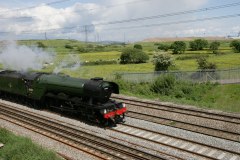The Flying Scotsman is a famous steam locomotive that is known for its iconic status in the history of railways. It was originally built in 1923 for the London and North Eastern Railway (LNER) in the United Kingdom. The locomotive's official number is 4472, and it was designed by Sir Nigel Gresley, one of Britain's most renowned steam locomotive engineers.
The Flying Scotsman gained significant popularity due to its speed and luxurious design. It became the first steam locomotive to reach a speed of 100 miles per hour (160 kilometers per hour) in 1934, making it a symbol of British engineering prowess. The locomotive was primarily used on the London to Edinburgh route, which inspired its name, "The Flying Scotsman."
Over the years, the locomotive underwent various modifications and changes, including the fitting of a new type of tender and an extended corridor-style cab. It has also appeared in several films, documentaries, and special events, further enhancing its fame.
In 2004, after a series of ownership changes, The Flying Scotsman was purchased by the National Railway Museum in York, England. The locomotive underwent a major restoration that lasted from 2006 to 2016, with the aim of bringing it back to its former glory. The restoration project involved dismantling the locomotive to its individual components and rebuilding it to original specifications.
Since its restoration, The Flying Scotsman has been operating on various heritage and mainline railway excursions across the United Kingdom. It continues to captivate railway enthusiasts and the general public with its beauty and historical significance.
Please note that the information provided above is accurate up until my knowledge cutoff in September 2021. For the most up-to-date information on The Flying Scotsman, I recommend referring to official sources or recent news articles.


















